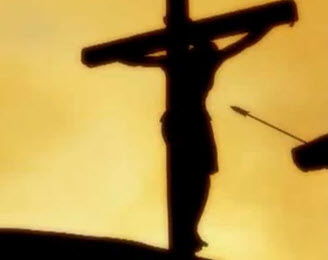Pierced with a spear – when?
30-04-2025 - Posted by Geert-JanOriginally posted on April 23 – by Andre Piet This blog is a thorough revision of an article from 1 March 2020.
According to most Bible translations, the spear thrust into Jesus’ side took place only after He had already died. This interpretation is based on John 19:32–35:
John. 19:32–35 (CLNT)
The soldiers, then, came and break the legs of the first and of the other who is crucified together with Him.
Yet, coming on Jesus, as they perceived He has already died, they do not break His legs.
But one of the soldiers pierces His side with a lance, and straightway out came blood and water.
At first glance, this appears to be a chronological sequence: first the confirmation of Jesus’ death, then the spear thrust. But this common interpretation raises fundamental questions that cannot simply be ignored.
- Why was Jesus still pierced with a lance if He had already died?
If the soldiers were convinced of His death, the spear thrust would have been unnecessary. If they had any doubts, why did they not break His legs, as they did with the others? - Why did Jesus die so remarkably quickly? His early death was so unusual that even Pilate was surprised by it (Mk. 15:44). Crucifixion normally led to death only after many hours, or even days.
- How could “blood and water” come out immediately from the wound? In a deceased body, blood circulation stops. That “straightway” blood and water came out of Jesus’ side rather points to an act that occurred before death, while the heart was still pumping and blood pressure was still active.
These questions challenge the assumed clarity of the traditional explanation. But there is more.
The missing spear thrust in Matthew 27:49
In a number of the oldest and most authoritative manuscripts of the New Testament — including Codex Vaticanus and Codex Sinaiticus — Matthew 27:49 contains a sentence that strikingly resembles John 19:34:
“And another, taking a lance head, pierces His side, and water and blood came out.”
This sentence has been omitted from nearly all modern translations, despite its strong manuscript support. The most common explanation is that this text was a later addition, inspired by John’s account. But this explanation seems to be driven merely by theological discomfort. Only because scholars were unable to reconcile Matthew’s statement with John’s narrative, the line in Matthew has been dismissed as inauthentic. But what if the original and fuller version of Matthew 27:49 actually provides the key to understanding what truly took place at the cross?
An alternative, consistent reading of John 19:34
If we read John 19:34 as an explanation of Jesus’ death, rather than as an event after His death, a surprisingly consistent interpretation emerges. Then the text, paraphrased, would say the following:
Because one of the soldiers had pierced His side with a lance (from which blood and water immediately came forth), they saw that He had already died and therefore did not break His legs.
The wording in John 19:34 allows for two possible readings: chronological and explanatory. In the first case, verse 34 is a chronological continuation of verse 33. In the second, verse 34 explains the statement in verse 33. Both readings are possible, since the text does not explicitly state that the spear thrust occurred after Jesus’ death. Nor does it contain words such as “because” or “therefore.” Yet this is not an insurmountable objection. There are many examples in Scripture where a causal relationship is implied rather than explicitly stated (see Gen. 4:8; 2 Sam. 11:2–4; Jn. 18:6). John 19:34 can likewise be understood as an explanation of why Jesus was already dead. The verb form used for the piercing of the spear (aorist) also allows for this in Greek. Aorist, by nature, does not convey timing of the action on its own. If we take John 19:34 as explanatory, the spear thrust is not something that happened after death, but rather the very act that led to Jesus’ death.
This interpretation not only better addresses the medical and logical objections to the traditional reading, but also aligns with the text of Matthew 27:49 as found in the oldest manuscripts. The spear thrust was not an epilogue to an already dead body, but the fatal act that caused Jesus to die — through blood loss.
Jesus as the slaughtered Passover Lamb
This reading also carries a profound typological significance. John himself emphasizes:
“For these things occurred that the scripture may be fulfilled: A bone of Him shall not be crushed.” (Jn. 19:36, CLNT)
The Passover, which was slaughtered on the 14th of Nisan, was not to have any bone broken (Ex. 12:46). Jesus’ death through blood loss — without a single bone being broken — makes Him the literal fulfillment of this requirement. John testifies emphatically that he saw this himself and highlights its significance for those who are to believe.
That Jesus was thus “slaughtered” — in the most literal sense of the word — aligns perfectly with the Passover character John associates with the cross. It is not merely symbolic, but an exact fulfillment!
Conclusion
The alternative reading of John 19:34 is grammatically sound, textually supported, logically coherent, and typologically self-evident. It therefore deserves to be taken seriously — not as a curiosity, but as a credible explanation of what took place at the cross.
Anyone who wishes to understand John in light of the entirety of Scripture — and with regard to the early textual witnesses of the New Testament — can hardly ignore this reading. The spear thrust is not an epilogue, but the decisive act that sealed Jesus’ death — as the Lamb of God Who is taking away the sin of the world.

 English Blog
English Blog